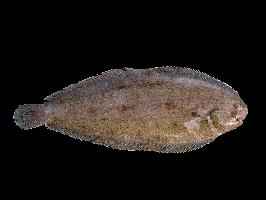
Poids et mesures
| Longueur | 70 cm |
|---|---|
| Poids | 3 kg |
Données biologiques
| Durée de vie | 26 r |
|---|
Description de l'animal
The Common sole, scientifically known as Solea solea, is a demersal fish species that is widely distributed across the sandy and muddy bottoms of the Northeast Atlantic and Mediterranean Sea. This flatfish is particularly esteemed for its delicate flesh, making it a prized catch in the culinary world.An adult Common sole typically exhibits a slender, elongated body that can grow up to 70 centimeters in length, although the average size is usually around 30 centimeters. The body of the sole is remarkably flat and asymmetrical, a common trait among flatfish, which allows it to blend seamlessly with the seabed. The upper side of the sole is pigmented, usually displaying a mottled brown coloration with occasional darker spots and blotches that serve as camouflage against predators. This pigmentation is an excellent adaptation for a benthic lifestyle, as it provides the fish with a means of concealment against the backdrop of sandy and muddy substrates. The underside of the sole, however, remains white and pigment-free, a contrast to its darker upper surface.
One of the most distinctive features of the Common sole is the positioning of its eyes. During its larval stage, the sole starts with one eye on each side of its head, as is typical for most fish. However, as it matures, it undergoes a metamorphosis where one eye migrates to the other side of the head, resulting in both eyes being located on the pigmented side. This adaptation is beneficial for a life spent predominantly lying flat on the sea floor.
The Common sole has a small mouth with a slightly protruding lower jaw, which it uses to feed on a diet consisting mainly of small benthic invertebrates such as worms, crustaceans, and mollusks. Its feeding strategy involves lying partially buried in the sediment and ambushing prey that comes within reach.
This species exhibits a seasonal migratory pattern, moving into deeper waters during the winter and returning to shallower coastal areas to spawn in the spring and summer months. Spawning takes place between the months of April and August, depending on the geographical location. After spawning, the fertilized eggs float near the surface until they hatch, and the larvae begin their life cycle, eventually settling on the bottom to grow and mature.
In terms of habitat, the Common sole prefers temperate waters and is typically found at depths ranging from the intertidal zone down to about 200 meters. Its preference for soft substrates like sand and mud is due to the ease with which it can burrow and hide from predators, as well as its hunting strategy for capturing prey.
Conservation-wise, the Common sole is subject to fishing pressure throughout its range, and as such, there are regulations and quotas in place to manage stocks and ensure sustainable harvests. It is important for fisheries to monitor sole populations closely to avoid overfishing and to maintain the species' role in the marine ecosystem.
In summary, the Common sole (Solea solea) is a fascinating marine species with unique adaptations that allow it to thrive on the ocean floor. Its value as a food source has made it an important species for commercial fisheries, and its biology and behavior continue to be of interest to marine scientists and ecologists.
Nouvelles photos d'animaux
Top 10 des animaux
- Dolphin gull (Leucophaeus scoresbii)
- Diana monkey (Cercopithecus diana)
- Moustached guenon (Cercopithecus cephus)
- Galápagos tortoise (Geochelone nigra complex)
- Russian tortoise (Testudo horsfieldii)
- Japanese macaque (Macaca fuscata)
- Stone loach (Barbatula barbatula)
- Greek tortoise (Testudo graeca)
- Common flying dragon (Draco volans)
- Vendace (Coregonus albula)